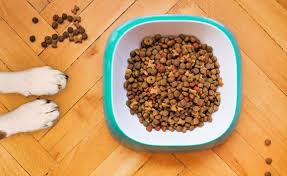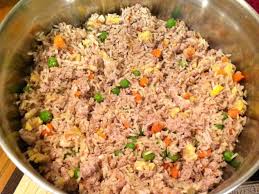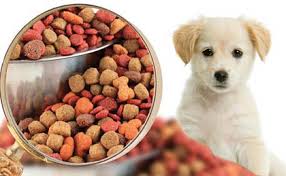Types of dog food are crucial in ensuring the health and well-being of your canine companion. Just like humans, dogs require a balanced diet to thrive, which includes the right mix of proteins, carbohydrates, fats, vitamins, and minerals. With numerous options available on the market, it can be challenging for pet owners to choose the best food for their dogs.
The right diet can support growth, maintain energy levels, and contribute to overall health, while an improper diet can lead to various health issues. Understanding the different types of dog food available can help you make an informed choice that suits your dog’s specific needs.
One primary category of dog food is dry kibble, known for its convenience and cost-effectiveness. Kibble is typically made from a mixture of meat, grains, and vegetables that are cooked and then dried into bite-sized pieces. This type of food is easy to store, measure, and serve, making it a popular choice among dog owners. Additionally, dry kibble helps promote dental health by reducing plaque buildup through the chewing process.
Another common option is wet or canned dog food. This type of food usually contains a higher moisture content than kibble, making it more palatable and easier for some dogs to consume, especially those with dental issues or older dogs that may have difficulty chewing. Wet dog food is often packed with protein and can be mixed with kibble for a balanced diet. However, it can be more expensive and requires refrigeration after opening.
Raw dog food is gaining popularity among pet owners who prefer a natural diet for their dogs. This diet typically consists of uncooked meat, bones, fruits, and vegetables. Advocates of raw feeding argue that it mimics a dog’s natural diet and can lead to improved digestion, healthier skin, and a shinier coat. However, raw diets require careful preparation to ensure nutritional balance and avoid the risk of bacterial contamination.
Homemade dog food is another option for those who want to have complete control over their dog’s diet. Pet owners can prepare meals using fresh ingredients, tailoring recipes to their dog’s specific dietary needs. While homemade dog food can be nutritious, it’s essential to consult with a veterinarian or a pet nutritionist to ensure that all necessary nutrients are included in the diet.
Lastly, specialized dog food caters to specific health conditions or life stages. For instance, puppy food is formulated to support growth and development, while senior dog food contains lower calories and added joint support for aging dogs. There are also options for dogs with allergies or sensitivities, such as grain-free or limited-ingredient diets.
Here’s an article covering Dry Dog Food: Kibble, Wet Dog Food: Canned Options, and Semi-Moist Dog Food. Each section provides an overview of the different types of dog food and their characteristics.
Types of Dog Food

Choosing the right type of dog food is essential for maintaining your dog’s health and well-being. Here’s a breakdown of the main types of dog food available:
1. Dry Dog Food: Kibble
Dry dog food, commonly known as kibble, is one of the most popular choices among dog owners. It is convenient, affordable, and has a long shelf life.
i. Nutritional Balance: Kibble is often formulated to provide a balanced diet, containing proteins, carbohydrates, vitamins, and minerals necessary for your dog’s health.
ii. Dental Health Benefits: The crunchiness of kibble can help reduce plaque and tartar buildup on your dog’s teeth, promoting better dental health.
iii. Portion Control: Kibble makes it easier to measure out portions, helping prevent overfeeding and obesity.
2. Wet Dog Food: Canned Options
Wet dog food is packaged in cans or pouches and has a higher moisture content than dry food. This type of food is often more palatable for dogs, making it a great option for picky eaters.
i. Flavor and Aroma: The rich taste and smell of wet dog food can be more appealing to dogs, encouraging them to eat, especially if they are feeling unwell.
ii. Hydration: The high moisture content helps keep dogs hydrated, which is particularly beneficial for those who may not drink enough water.
iii. Soft Texture: Wet food is easier for older dogs or those with dental issues to chew, making it a good choice for senior dogs.
Semi-Moist Dog Food
Semi-moist dog food is a middle ground between dry kibble and wet food. It usually comes in pouches or trays and has a soft, chewy texture.
i. Convenience: Semi-moist food is easy to serve and often doesn’t require preparation, making it a convenient option for busy pet owners.
ii. Taste Appeal: This type of food tends to be more flavorful than dry kibble, which can help entice dogs to eat.
iii. Variety in Feeding: Semi-moist food can be used as a main diet or as a topping for dry food, providing variety in your dog’s meals.
Raw Dog Food: The Natural Diet
Raw dog food is based on a natural diet that includes uncooked meat, bones, fruits, and vegetables. This diet aims to mimic what dogs would eat in the wild.
1. Nutritional Benefits: Raw diets are often rich in proteins, vitamins, and minerals, promoting optimal health and muscle development.
2. Digestive Health: Proponents argue that raw food can lead to better digestion, as it includes natural enzymes and probiotics.
3. Coat Condition: Many owners report that dogs on a raw diet have shinier coats and healthier skin due to the high-quality fats found in raw meats.
4. Potential Risks: There are concerns about bacterial contamination (e.g., Salmonella) and an unbalanced diet if not properly formulated.
Read Also: Trichomoniasis: Description, Damages Caused, Control and Preventive Measures
Home-Cooked Dog Food

Home-cooked dog food is prepared by owners using fresh ingredients at home. This diet allows for complete control over what your dog eats.
1. Customization: Owners can tailor recipes to meet their dog’s specific dietary needs, including allergies or sensitivities.
2. Ingredient Quality: Using fresh, high-quality ingredients can lead to better nutrition compared to some commercial dog foods.
3. Health Monitoring: Cooking for your dog allows you to monitor their health closely, as you know exactly what they are consuming.
4. Time-Consuming: Preparing home-cooked meals can be time-intensive, and it requires knowledge to ensure balanced nutrition.
Grain-Free Dog Food
Grain-free dog food eliminates grains like wheat, corn, and soy from the diet, focusing on meat and alternative carbohydrate sources such as sweet potatoes or peas.
1. Digestive Ease: Some dogs may have sensitivities to grains, leading to digestive issues. Grain-free diets can alleviate these problems for those dogs.
2. High Protein Content: Grain-free foods often contain higher levels of protein, which can be beneficial for active dogs.
3. Energy Levels: Many owners report that their dogs have increased energy and better overall health when switched to grain-free diets.
4. Not for All Dogs: Some experts caution that grain-free diets may not be suitable for every dog, especially those without specific grain sensitivities.
Limited Ingredient Diets
Limited ingredient diets are designed to include fewer ingredients to reduce the risk of allergic reactions or sensitivities in dogs.
1. Allergy Management: These diets are often recommended for dogs with food allergies, as they allow owners to identify specific allergens easily.
2. Simplified Nutrition: Limited ingredient diets can provide balanced nutrition without overwhelming the dog’s system with many components.
3. Easier Identification: If a dog has adverse reactions, it’s easier to pinpoint the cause when fewer ingredients are involved.
4. Potential Nutritional Gaps: Owners must ensure that the limited ingredient diet still meets all nutritional requirements to avoid deficiencies.
Read Also: 18 Medicinal Health Benefits Of Ligustrum lucidum (Glossy Privet)
Prescription Dog Food: Medical Needs

Prescription dog food is specially formulated to address specific medical conditions or dietary requirements prescribed by a veterinarian.
1. Targeted Nutrition: These diets are designed to manage health issues such as allergies, kidney disease, diabetes, obesity, and gastrointestinal disorders. They contain specific nutrients that support healing or management of these conditions.
2. Veterinary Guidance: Prescription dog food should be used under the guidance of a veterinarian. They can assess your dog’s medical needs and recommend appropriate options.
3. Quality Assurance: Prescription diets undergo rigorous testing and quality control, ensuring they meet the specific dietary needs of dogs with health issues.
4. Cost Consideration: Prescription dog food can be more expensive than regular pet food, so it’s essential to discuss the long-term needs and budget with your veterinarian.
Organic and Natural Dog Food
Organic and natural dog food is made from high-quality ingredients without synthetic additives, preservatives, or artificial flavors.
1. Ingredient Integrity: Organic dog food is produced without pesticides, antibiotics, or hormones, offering a more natural diet that some pet owners prefer.
2. Nutritional Benefits: These diets often contain higher-quality protein sources, whole grains, and fresh fruits and vegetables, providing balanced nutrition.
3. Environmental Considerations: Many organic and natural dog food brands prioritize sustainable farming practices, which can be appealing to environmentally-conscious pet owners.
4. Certification: Look for labels that indicate the food is certified organic to ensure it meets specific standards.
Choosing the Right Dog Food for Your Pet
Selecting the right dog food is crucial for your pet’s health and well-being. Here are some key considerations to help you make the best choice:
1. Age and Size: Dogs have different nutritional needs based on their age, size, and breed. Puppies require diets higher in protein and calories, while senior dogs may need lower calories and specific nutrients to support aging.
2. Health Considerations: If your dog has any health issues or allergies, consult with your veterinarian to determine the best diet that addresses these needs.
3. Ingredient Quality: Look for high-quality ingredients, such as whole meats, whole grains, and fresh vegetables. Avoid foods with excessive fillers or artificial additives.
4. Feeding Guidelines: Follow the feeding guidelines on the packaging and adjust portions based on your dog’s activity level, weight, and health status.
5. Transition Gradually: When switching to a new food, transition gradually over a week or more to prevent digestive upset. Mix increasing amounts of the new food with the old food.
Do you have any questions, suggestions, or contributions? If so, please feel free to use the comment box below to share your thoughts. We also encourage you to kindly share this information with others who might benefit from it. Since we can’t reach everyone at once, we truly appreciate your help in spreading the word. Thank you so much for your support and for sharing!
Read Also: 1Hydroponics Guide 101: All You Need to Know About it






